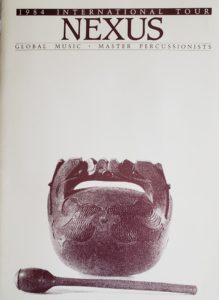 #NEXUSat50 1984 FOUR MONTH WORLD TOUR: CHINA! In May we embarked on a tour that would take us to 10 countries. This meant putting a great many other things in Life on hold – but what an opportunity! We began in China where we were the first Western percussion group to perform in the People’s Republic. A few short years after our visit, China would re-open its borders to the Western world – but not yet. There are far more stories than can be told here, but we will try to give you a few highlights. John Wyre arrived in Beijing 3 days before NEXUS, in part to ensure the arrival and care of our 30 or more flight cases filled with literally hundreds of instruments. He had learned a few paragraphs of Chinese for the welcoming banquet and had Russell’s student Stephen Lee write it out phonetically and coach him in the necessary musical inflections. He writes, “Every morning I walked from the hotel to the Temple of Heaven and through the gardens reciting my two paragraphs of Chinese over and over.” At the welcoming banquet, there were many toasts made with mao tai. He says, “They drink it in tiny glasses, which is an indication out in front that we’re dealing with some toxic stuff. When you pour it into the glass it emits a smoky vapor…by the time we were just halfway through the appetizers we had already thrown back five hits of this stuff. The doubts began to creep in…my heart was pounding in my chest like the bass drum part in the “Pines of Rome”…I stood up and launched into my speech before Mr. Hu found another opportunity to raise his glass. The applause after the opening paragraph was long enough to allow me a slow deep breath…As I began the final section I could see light at the end of the tunnel, segued right into a toast to the universal language of music, and oozed into my chair to receive the next blast of mao tai.” John recalled, “It is not uncommon for Chinese audiences to talk during performances, discussing the music, the price of rice…We had to raise the volume levels of some of our more gentle repertoire like Rain Tree. With each change in Music for Pieces of Wood came a…wave of conversation that began in the front and worked its way to the rear of the hall, gradually fading into more attentive listening until the next change…An amazing ebb and flow between music and audience.” Bill recalls Chinese drummers intrigued by the NEXUS instruments. The guide explained that some our old Chinese instruments were unfamiliar because traditional instruments had been destroyed in the 1960s Cultural Revolution in the zeal to remove any reminder of China’s colonial past. Bill says, “At our first concert we were informed that our audience would consist of peasant farmers who had been bussed in from the surrounding countryside. They had been working at their normal chores when they were drafted by the Ministry of Culture and herded onto busses heading to our concert. They had surely never heard a percussion ensemble concert in their lives…During all the first few pieces we watched as they broke into conversations, eating snacks from noisy paper bags…as if NEXUS was in another building.” Should we continue? We decided to go ahead with The Birds scored for piano and a hundred different bird calls. “Two minutes into the nightingale calls the paper bags were set aside, conversations ceased…the applause after the final chord left no doubt – contact and success!”
#NEXUSat50 1984 FOUR MONTH WORLD TOUR: CHINA! In May we embarked on a tour that would take us to 10 countries. This meant putting a great many other things in Life on hold – but what an opportunity! We began in China where we were the first Western percussion group to perform in the People’s Republic. A few short years after our visit, China would re-open its borders to the Western world – but not yet. There are far more stories than can be told here, but we will try to give you a few highlights. John Wyre arrived in Beijing 3 days before NEXUS, in part to ensure the arrival and care of our 30 or more flight cases filled with literally hundreds of instruments. He had learned a few paragraphs of Chinese for the welcoming banquet and had Russell’s student Stephen Lee write it out phonetically and coach him in the necessary musical inflections. He writes, “Every morning I walked from the hotel to the Temple of Heaven and through the gardens reciting my two paragraphs of Chinese over and over.” At the welcoming banquet, there were many toasts made with mao tai. He says, “They drink it in tiny glasses, which is an indication out in front that we’re dealing with some toxic stuff. When you pour it into the glass it emits a smoky vapor…by the time we were just halfway through the appetizers we had already thrown back five hits of this stuff. The doubts began to creep in…my heart was pounding in my chest like the bass drum part in the “Pines of Rome”…I stood up and launched into my speech before Mr. Hu found another opportunity to raise his glass. The applause after the opening paragraph was long enough to allow me a slow deep breath…As I began the final section I could see light at the end of the tunnel, segued right into a toast to the universal language of music, and oozed into my chair to receive the next blast of mao tai.” John recalled, “It is not uncommon for Chinese audiences to talk during performances, discussing the music, the price of rice…We had to raise the volume levels of some of our more gentle repertoire like Rain Tree. With each change in Music for Pieces of Wood came a…wave of conversation that began in the front and worked its way to the rear of the hall, gradually fading into more attentive listening until the next change…An amazing ebb and flow between music and audience.” Bill recalls Chinese drummers intrigued by the NEXUS instruments. The guide explained that some our old Chinese instruments were unfamiliar because traditional instruments had been destroyed in the 1960s Cultural Revolution in the zeal to remove any reminder of China’s colonial past. Bill says, “At our first concert we were informed that our audience would consist of peasant farmers who had been bussed in from the surrounding countryside. They had been working at their normal chores when they were drafted by the Ministry of Culture and herded onto busses heading to our concert. They had surely never heard a percussion ensemble concert in their lives…During all the first few pieces we watched as they broke into conversations, eating snacks from noisy paper bags…as if NEXUS was in another building.” Should we continue? We decided to go ahead with The Birds scored for piano and a hundred different bird calls. “Two minutes into the nightingale calls the paper bags were set aside, conversations ceased…the applause after the final chord left no doubt – contact and success!”
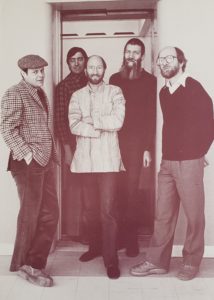 Read more: Bill’s adventure with a savory duck foot – webs and all – at that welcoming banquet, in his “Unpopular Music”. Robin Engelman kept a detailed diary throughout the tour and you can read it on his blog, beginning with Part 1 at https://robinengelman.com/2013/08/23/nexus-world-tour-1984-a-diary-part-1/.
Read more: Bill’s adventure with a savory duck foot – webs and all – at that welcoming banquet, in his “Unpopular Music”. Robin Engelman kept a detailed diary throughout the tour and you can read it on his blog, beginning with Part 1 at https://robinengelman.com/2013/08/23/nexus-world-tour-1984-a-diary-part-1/.
#NEXUSat50 1984 GONGS and CYMBALS and BELLS, SHANGHAI In Beijing our bus driver asked if we would like to see the largest bell in China. Robin recalled “a tiny road between low China housing – we turn a corner and there is a temple…[and] 30 or 40 bells resting on concrete blocks in a courtyard – all sizes some, beautifully inscribed, one huge about 16 feet tall. We pass through another gate and The Bell awaits us in a pavilion. It is huge and hanging. Perhaps 40 feet tall? But as interesting are the characters – tiny Chinese characters cast over the entire surface. We go through a little gate, down a few steps and stand under the bell – our whole group can easily stand within its circumference. Law decrees ringing the bell once a year at Spring Festival. Rumour has it that all of Beijing can hear it.
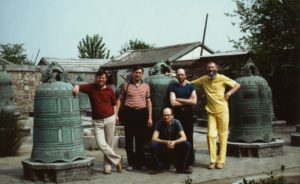 In a small building near the Temple is a bronze bowl filled with water-about the size of the washbasin. It has a handle on either side of the top rim. By wetting your hands and rubbing hard enough the bowl begins to vibrate and produces a beautiful low bell-like tone. This vibration makes the water in the bowl throw up showers and tiny droplets. Everyone has a go at it and only our bus driver is unable to make it work.” From Beijing we took a 2 hour nerve-wracking turbulent night flight to Shanghai for concerts. On a free day there, we asked to travel to an instrument factory – a 3 hour bus trip to Suzhou on a one-lane road shared by motor vehicles, bikers, pedestrians and assorted herds of animals. Bill says, “Just as the Inuit people of the north have many words for the colour white, so Chinese musicians have developed many styles of gongs and cymbals, each with its own subtle characteristics” and so we heard “instruments until that moment unknown to us – wind gongs, cloud gongs, winter gongs, on and on. We purchased as many instruments as we could carry with us – except for one drum that was so large it would have to be shipped back to John Wyre’s home – a voyage that would take months.” Robin recalled that the contract negotiations and payment took hours, so the bus back was the same hazardous trip, in darkness! “Many people in dark blue clothes walk the roads and we are driving without lights. When it gets totally dark our driver turns on his lights but turns them off when another truck or bus approaches.” Nor was the driver interested in slackening speed. The next day we visited a gong/cymbal shop in Shanghai on foot, followed by a knot of curious onlookers. Bill says, “I picked out a number of cloud gongs and asked in sign language if they could be tuned to specific pitches…He then reached for his 3-pound sledgehammer and one-by-one he carefully hammered on the gongs, changing the tuning of each until there was a chromatic tuned set of two full octaves. Then he placed them all on a scale to weigh them. The price was determined simply by the total weight, not by the quantity or quality – a fact that caused all of us the chuckle incredulously.” Next stop Korea: “We are having continuous negotiations with the Chinese about our instruments leaving China on time for Korea and the cost of sending them and the complications seem to be enormous,” recalled Robin.
In a small building near the Temple is a bronze bowl filled with water-about the size of the washbasin. It has a handle on either side of the top rim. By wetting your hands and rubbing hard enough the bowl begins to vibrate and produces a beautiful low bell-like tone. This vibration makes the water in the bowl throw up showers and tiny droplets. Everyone has a go at it and only our bus driver is unable to make it work.” From Beijing we took a 2 hour nerve-wracking turbulent night flight to Shanghai for concerts. On a free day there, we asked to travel to an instrument factory – a 3 hour bus trip to Suzhou on a one-lane road shared by motor vehicles, bikers, pedestrians and assorted herds of animals. Bill says, “Just as the Inuit people of the north have many words for the colour white, so Chinese musicians have developed many styles of gongs and cymbals, each with its own subtle characteristics” and so we heard “instruments until that moment unknown to us – wind gongs, cloud gongs, winter gongs, on and on. We purchased as many instruments as we could carry with us – except for one drum that was so large it would have to be shipped back to John Wyre’s home – a voyage that would take months.” Robin recalled that the contract negotiations and payment took hours, so the bus back was the same hazardous trip, in darkness! “Many people in dark blue clothes walk the roads and we are driving without lights. When it gets totally dark our driver turns on his lights but turns them off when another truck or bus approaches.” Nor was the driver interested in slackening speed. The next day we visited a gong/cymbal shop in Shanghai on foot, followed by a knot of curious onlookers. Bill says, “I picked out a number of cloud gongs and asked in sign language if they could be tuned to specific pitches…He then reached for his 3-pound sledgehammer and one-by-one he carefully hammered on the gongs, changing the tuning of each until there was a chromatic tuned set of two full octaves. Then he placed them all on a scale to weigh them. The price was determined simply by the total weight, not by the quantity or quality – a fact that caused all of us the chuckle incredulously.” Next stop Korea: “We are having continuous negotiations with the Chinese about our instruments leaving China on time for Korea and the cost of sending them and the complications seem to be enormous,” recalled Robin.
Read more: Bill Cahn has a fascinating chapter in his book “Unpopular Music”. Robin’s diary entries for Shanghai can be seen at https://robinengelman.com/2015/01/23/nexus-world-tour-1984-a-diary-part-7/
#NEXUSat50 1984 CAGE QUERY, SEOUL, KOREA Here we did a radio taping at KBS Studios, a TV taping at the Sejong Cultural Center, and also performed at Hanyang University. You can see and hear the tapings on YouTube at https://www.youtube.com/user/billcahn/videos. Look for “1984” and you will find Valse Brillante, Third Construction, The Birds, Jovial Jasper, Ancient Military Aires, and Fluffy Ruffles. Bob says, “John Cage is one of the group’s favourite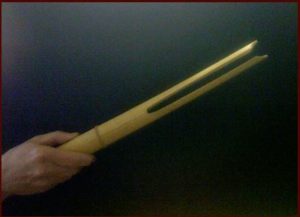 composers, as well as Lou Harrison. Both wrote many works for percussion during the ’30s and ’40s. It’s rare to find pieces of that clarity today, so we still play a lot of their music. Cage’s 1943 composition, Third Construction, is…full of interesting sounds, is complicated, yet accessible. It calls for odd instruments such as tom-toms, a donkey’s jawbone, lion’s roar, cricket caller and graduated tin cans.” Bill received an inquiry about the “cricket callers” we used in John Cage’s Third Construction for that taping. (The performance can be viewed at https://www.youtube.com/watch?v=C_ZHd-ReIUg ). Here is his reply: “The instruments used on the 1984 Seoul, Korea performance in the video were split bamboo tubes that were called “devil chasers” when I purchased them from Steve Weiss in the 1970s. These were also used on the 1989 NEXUS recording of the piece (“The Best of NEXUS” – NEXUS CD #10251). Since about 2004 I have used small plastic toy shakers that I purchased in a toy store for 50-cents each. (see photos). I wish now that I had purchased the whole box of toy shakers, because I have not seen them anywhere else since. The main problem with the “cricket caller” part is that while the “devil chasers” are split bamboo as indicated, it’s not possible for these instruments to play a tremolo as notated in the part; my decision was to play a stream of 8th-notes instead of tremolos. Cage never said a word about these instruments to me, so I assume he was OK with them. That being said, I now use the plastic toys because I really like the higher sound (more like a cricket sound), especially in contrast with the instruments used by the other players, and the tremolos are easily playable.”
composers, as well as Lou Harrison. Both wrote many works for percussion during the ’30s and ’40s. It’s rare to find pieces of that clarity today, so we still play a lot of their music. Cage’s 1943 composition, Third Construction, is…full of interesting sounds, is complicated, yet accessible. It calls for odd instruments such as tom-toms, a donkey’s jawbone, lion’s roar, cricket caller and graduated tin cans.” Bill received an inquiry about the “cricket callers” we used in John Cage’s Third Construction for that taping. (The performance can be viewed at https://www.youtube.com/watch?v=C_ZHd-ReIUg ). Here is his reply: “The instruments used on the 1984 Seoul, Korea performance in the video were split bamboo tubes that were called “devil chasers” when I purchased them from Steve Weiss in the 1970s. These were also used on the 1989 NEXUS recording of the piece (“The Best of NEXUS” – NEXUS CD #10251). Since about 2004 I have used small plastic toy shakers that I purchased in a toy store for 50-cents each. (see photos). I wish now that I had purchased the whole box of toy shakers, because I have not seen them anywhere else since. The main problem with the “cricket caller” part is that while the “devil chasers” are split bamboo as indicated, it’s not possible for these instruments to play a tremolo as notated in the part; my decision was to play a stream of 8th-notes instead of tremolos. Cage never said a word about these instruments to me, so I assume he was OK with them. That being said, I now use the plastic toys because I really like the higher sound (more like a cricket sound), especially in contrast with the instruments used by the other players, and the tremolos are easily playable.”
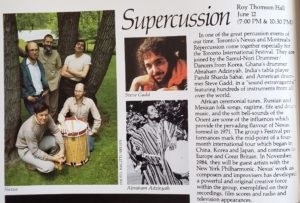
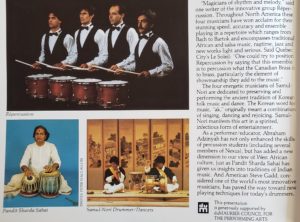 #NEXUSat50 1984 SUPERCUSSION! From Korea we headed to Japan where we were featured on Takemitsu’s “Music Today” series. On @BillCahn’s YouTube channel https://www.youtube.com/user/billcahn/videos you can hear “Keep Movin’” and “Indian Story” from those concerts. Bob recalls instrument shopping and then (once home) asking Andrew Feldman to create the proper mallets based on traditional oriental designs. He says, “Our stops in China, Japan and Korea resulted in a major growth in my collection of gongs, small tam tams and cymbals. We still included improvisation as a major element on our programs, and I wanted to incorporate as many of these instruments as possible in my setups. It was a challenge to make the kinds of sounds I wanted on a large assortment of metal instruments, and so I asked Andrew.” Bill has a great story of Ruth Cahn’s strong reaction to a runaway eel at the fishmonger’s. Later at dinner, “Ruth recounted the story…to the delight of all…After the final course…as usual, we had no idea of what had been served, [so] we asked Takemitsu who promptly responded, “You have just consumed your fears!” We had presented some challenging repertoire on the Asian leg of our World Tour: Reich, Cage, Mather, Cahn, Becker, African pieces. We had the Chinese piece Hai Shang – Luogu arranged for NEXUS by Tan Pei-Min. In Tokyo, we performed Teddy At The Throttle! But now we returned to Canada to appear in the Toronto International Festival celebrating Toronto’s Sesquicentennial. This multi-million dollar event had been 3 years in the curating and throughout June brought in artists of all genres from around the world: e.g. The Hamburg Ballet, troupes from India and Japan, choirs from Europe, jazz artists, The Metropolitan Opera in 8 different operas…In keeping with this cornucopia, John Wyre initiated and organized the precursor to his future World Drums events and called it Supercussion. It was a wonderful event – and we presented it twice in one day! Read more: Bob’s mallets: https://www.nexuspercussion.com/2014/08/andrew-feldman-an-appreciation/; Bill Cahn’s book “Unpopular Music” available as digital download from billcahn@aol.com.
#NEXUSat50 1984 SUPERCUSSION! From Korea we headed to Japan where we were featured on Takemitsu’s “Music Today” series. On @BillCahn’s YouTube channel https://www.youtube.com/user/billcahn/videos you can hear “Keep Movin’” and “Indian Story” from those concerts. Bob recalls instrument shopping and then (once home) asking Andrew Feldman to create the proper mallets based on traditional oriental designs. He says, “Our stops in China, Japan and Korea resulted in a major growth in my collection of gongs, small tam tams and cymbals. We still included improvisation as a major element on our programs, and I wanted to incorporate as many of these instruments as possible in my setups. It was a challenge to make the kinds of sounds I wanted on a large assortment of metal instruments, and so I asked Andrew.” Bill has a great story of Ruth Cahn’s strong reaction to a runaway eel at the fishmonger’s. Later at dinner, “Ruth recounted the story…to the delight of all…After the final course…as usual, we had no idea of what had been served, [so] we asked Takemitsu who promptly responded, “You have just consumed your fears!” We had presented some challenging repertoire on the Asian leg of our World Tour: Reich, Cage, Mather, Cahn, Becker, African pieces. We had the Chinese piece Hai Shang – Luogu arranged for NEXUS by Tan Pei-Min. In Tokyo, we performed Teddy At The Throttle! But now we returned to Canada to appear in the Toronto International Festival celebrating Toronto’s Sesquicentennial. This multi-million dollar event had been 3 years in the curating and throughout June brought in artists of all genres from around the world: e.g. The Hamburg Ballet, troupes from India and Japan, choirs from Europe, jazz artists, The Metropolitan Opera in 8 different operas…In keeping with this cornucopia, John Wyre initiated and organized the precursor to his future World Drums events and called it Supercussion. It was a wonderful event – and we presented it twice in one day! Read more: Bob’s mallets: https://www.nexuspercussion.com/2014/08/andrew-feldman-an-appreciation/; Bill Cahn’s book “Unpopular Music” available as digital download from billcahn@aol.com.
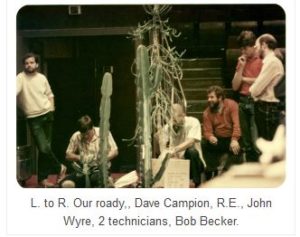 #NEXUSat50 1984 HECKLED IN HOLLAND The European leg of our World Tour began in Amsterdam at the Holland Festival. From Bob Becker: “We played two concerts there, including a monumental all-night improvisation in the Nieuwe Kirke. The festival director had issued a kind of challenge to NEXUS to do this, and of course, John Wyre agreed on our behalf without hesitation. We began our first concert a day after arriving in Holland, starting around 10:00 PM and continuing without a break until sunrise. Jet lag actually worked in our favour in this case, and most of the die-hard audience stayed for the entire event.” The Festival wanted a John Cage piece “Branches” (1976), a piece composed to be performed on amplified cactuses and a pod rattle (one of Cage’s favourite instruments). Robin recalled that we “spent an afternoon shopping for cactus, an adventure that blew away my mid-tour doldrums.” The sound technicians at the very large Carré Theatre provided exceptionally sensitive contact mics and a very good sound system. The cacti were large, one over 3 feet. We would pluck the spines. John Wyre writes that the strong spines offer various pitches and a strong rich sound “while others offer such a thick crop of wispy needle-like spines that performance is more challenging…even dangerous.” Bob takes up the tale: “During the evening performance of the piece, while we were making delicate plucking sounds on the cactus quills, someone in the audience (‘with bravura vocal cords’ wrote Robin) loudly exclaimed ‘bull shit!’ Without any change of attention or focus on what he was playing, Robin Engelman responded in his most powerful voice of authority ‘No, CACTUS shit!’ “ And that was our concert review headline the next day.
#NEXUSat50 1984 HECKLED IN HOLLAND The European leg of our World Tour began in Amsterdam at the Holland Festival. From Bob Becker: “We played two concerts there, including a monumental all-night improvisation in the Nieuwe Kirke. The festival director had issued a kind of challenge to NEXUS to do this, and of course, John Wyre agreed on our behalf without hesitation. We began our first concert a day after arriving in Holland, starting around 10:00 PM and continuing without a break until sunrise. Jet lag actually worked in our favour in this case, and most of the die-hard audience stayed for the entire event.” The Festival wanted a John Cage piece “Branches” (1976), a piece composed to be performed on amplified cactuses and a pod rattle (one of Cage’s favourite instruments). Robin recalled that we “spent an afternoon shopping for cactus, an adventure that blew away my mid-tour doldrums.” The sound technicians at the very large Carré Theatre provided exceptionally sensitive contact mics and a very good sound system. The cacti were large, one over 3 feet. We would pluck the spines. John Wyre writes that the strong spines offer various pitches and a strong rich sound “while others offer such a thick crop of wispy needle-like spines that performance is more challenging…even dangerous.” Bob takes up the tale: “During the evening performance of the piece, while we were making delicate plucking sounds on the cactus quills, someone in the audience (‘with bravura vocal cords’ wrote Robin) loudly exclaimed ‘bull shit!’ Without any change of attention or focus on what he was playing, Robin Engelman responded in his most powerful voice of authority ‘No, CACTUS shit!’ “ And that was our concert review headline the next day.
Bob, John, Robin and Bill all have written about this moment, engraved in our memories. John writes, “The audience responded in a fit of laughter, a wonderful, spontaneous sonic event, removing all tension from the room and allowing us to finish the performance with a new concentration.” The review appeared in de Volkskrant, June 25, 1984, and highlighted that once-in-a-lifetime moment, with a photo of NEXUS playing “Branches”. The photo is from Robin’s blog at robinengelman.com.
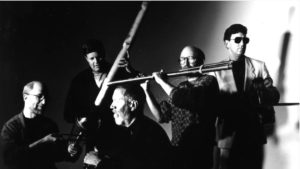 #NEXUSat50 1984 UN-“CAGED” IN FINLAND: July took us to Denmark, Germany and Finland. In Copenhagen, we performed at St. Nikolaj Church with its astonishing tower dating from the early 13th century. (Hans Christian Andersen wrote a theatrical drama entitled “Love of Nicolai Tower” performed in 1829.) The church is in the centre of the ancient city and today is known as the Nikolaj Contemporary Art Centre. We spent a wonderfully full week in Finland, much of it at the Kuhmo Festival but also at the Helsinki Summer Festival. We also had a run-out to the small town of Viitisarri, where Bill Cahn unearthed an interesting percussion story: “We were touring Finland and in Viitasaari we heard stories about a recent visit by John Cage, and we were shown a video demonstrating some of the resulting events. It seems that the town board had invited Cage – by then a fairly well-known American composer – to participate in the town’s music festival. During the course of his visit, Cage performed his music, including “Branches” which had the cumulative effect of causing the young people of Viitasaari to go on an “anything-goes” noisemaking rampage throughout the town, much of which was captured on video. It is my understanding that following the festival, in the political residue, the entire town board was voted out. Whether or not the details of this story are true, it is certainly the case that John Cage, a calm, soft-spoken man with fairly easy-to-understand ideas, frequently found himself surrounded by violent intellectual storms among those in the musical and academic establishments.” (from Bill’s blog post, Percussion Un-Caged: https://www.nexuspercussion.com/2009/11/percussion-un-caged/ )
#NEXUSat50 1984 UN-“CAGED” IN FINLAND: July took us to Denmark, Germany and Finland. In Copenhagen, we performed at St. Nikolaj Church with its astonishing tower dating from the early 13th century. (Hans Christian Andersen wrote a theatrical drama entitled “Love of Nicolai Tower” performed in 1829.) The church is in the centre of the ancient city and today is known as the Nikolaj Contemporary Art Centre. We spent a wonderfully full week in Finland, much of it at the Kuhmo Festival but also at the Helsinki Summer Festival. We also had a run-out to the small town of Viitisarri, where Bill Cahn unearthed an interesting percussion story: “We were touring Finland and in Viitasaari we heard stories about a recent visit by John Cage, and we were shown a video demonstrating some of the resulting events. It seems that the town board had invited Cage – by then a fairly well-known American composer – to participate in the town’s music festival. During the course of his visit, Cage performed his music, including “Branches” which had the cumulative effect of causing the young people of Viitasaari to go on an “anything-goes” noisemaking rampage throughout the town, much of which was captured on video. It is my understanding that following the festival, in the political residue, the entire town board was voted out. Whether or not the details of this story are true, it is certainly the case that John Cage, a calm, soft-spoken man with fairly easy-to-understand ideas, frequently found himself surrounded by violent intellectual storms among those in the musical and academic establishments.” (from Bill’s blog post, Percussion Un-Caged: https://www.nexuspercussion.com/2009/11/percussion-un-caged/ )
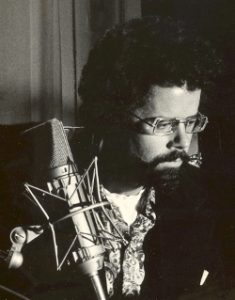 #NEXUSat50 1984 DANCE VARIATIONS Following a concert in Köln, Germany we had an opportunity to do a recording for the Westdeutscher Rundfunk (WDR) in Studio Nedeltschev. A couple of years before, Bob Becker had organized a commission for a new work from the distinguished Canadian composer John Hawkins (pictured). Bob tells us more: “Dance Variations is a major 20-minute work in six movements. The overall architecture of the piece is an arch form, with the basic material presented in a short first movement. The second movement adds additional ideas, which are then developed at length in the extensive third and fourth movements. The final two movements are again shorter and coda-like. As is typical of Hawkins’ mature work, the music is intricately crafted and rhythmically complex; however, the underlying harmonic style is drawn from popular song forms, and in particular, idioms of the Broadway musical. The fourth movement itself is structured as a broad arch, mirroring the general form of the piece, and follows an accelerating, and then decelerating tempo. It features highly elaborate and developmental writing for the marimba, accompanied by tuned roto-toms – a unique orchestrational idea. At the time it was the most challenging marimba part I had ever faced, and it remains one of the most difficult pieces in my repertoire. The recording of this movement, which was made in a single take, includes John Wyre on roto-toms, Russ Hartenberger on glockenspiel, and Robin Engelman on xylophone.” You can hear an excerpt in Bob’s blog post entitled “More from Bob’s Archive – Part 5”: https://www.nexuspercussion.com/2017/10/more-from-bobs-archive-part-5/. The piece as recorded by WDR in 1984 is included on the NEXUS CD “Rune” which was released in 1997.
#NEXUSat50 1984 DANCE VARIATIONS Following a concert in Köln, Germany we had an opportunity to do a recording for the Westdeutscher Rundfunk (WDR) in Studio Nedeltschev. A couple of years before, Bob Becker had organized a commission for a new work from the distinguished Canadian composer John Hawkins (pictured). Bob tells us more: “Dance Variations is a major 20-minute work in six movements. The overall architecture of the piece is an arch form, with the basic material presented in a short first movement. The second movement adds additional ideas, which are then developed at length in the extensive third and fourth movements. The final two movements are again shorter and coda-like. As is typical of Hawkins’ mature work, the music is intricately crafted and rhythmically complex; however, the underlying harmonic style is drawn from popular song forms, and in particular, idioms of the Broadway musical. The fourth movement itself is structured as a broad arch, mirroring the general form of the piece, and follows an accelerating, and then decelerating tempo. It features highly elaborate and developmental writing for the marimba, accompanied by tuned roto-toms – a unique orchestrational idea. At the time it was the most challenging marimba part I had ever faced, and it remains one of the most difficult pieces in my repertoire. The recording of this movement, which was made in a single take, includes John Wyre on roto-toms, Russ Hartenberger on glockenspiel, and Robin Engelman on xylophone.” You can hear an excerpt in Bob’s blog post entitled “More from Bob’s Archive – Part 5”: https://www.nexuspercussion.com/2017/10/more-from-bobs-archive-part-5/. The piece as recorded by WDR in 1984 is included on the NEXUS CD “Rune” which was released in 1997.
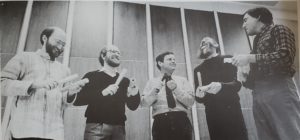 #NEXUSat50 1984 FINISHING WITH A FLOURISH August took us and our 30 trunks of instruments to the United Kingdom. We started at the recently-rechristened Queen’s Hall in Edinburgh (previously an 1823 church) and its newly-opened Canada Room. In Manchester, we performed for the BBC in their Playhouse Theatre production centre. (A couple of years after our visit, the BBC would sell it to the city where it is now the Nia Centre). We were welcomed to the Music at Oxford Summer Festival, and at the International Garden Festival in Liverpool where we presented a week of daily concerts. Robin and Bill took time out for a golf game at the Royal Liverpool Golf Club – “as prestigious as it sounds” says Bill, “though Robin in his wonderful nonchalant manner thought nothing of it.” At the sight of the challenging course, Bill bowed out to “observer” status, but Robin was at the height of his game, a scratch golfer. There was a wonderful “playing through” moment when Bill nervously watched the Club members perhaps “just waiting for this North American stranger to shank a few balls into the gorse. Robin raised the club, made his swing…’tick’…a perfect stroke as the ball shot out straight over the gorse and into the middle of the distant fairway. ‘Thank you, gentlemen!’ was all that Robin said as he handed his driver back to the caddie without the slightest hint of bravado” – leaving Bill doing mental fist-pumps, “YES!”
#NEXUSat50 1984 FINISHING WITH A FLOURISH August took us and our 30 trunks of instruments to the United Kingdom. We started at the recently-rechristened Queen’s Hall in Edinburgh (previously an 1823 church) and its newly-opened Canada Room. In Manchester, we performed for the BBC in their Playhouse Theatre production centre. (A couple of years after our visit, the BBC would sell it to the city where it is now the Nia Centre). We were welcomed to the Music at Oxford Summer Festival, and at the International Garden Festival in Liverpool where we presented a week of daily concerts. Robin and Bill took time out for a golf game at the Royal Liverpool Golf Club – “as prestigious as it sounds” says Bill, “though Robin in his wonderful nonchalant manner thought nothing of it.” At the sight of the challenging course, Bill bowed out to “observer” status, but Robin was at the height of his game, a scratch golfer. There was a wonderful “playing through” moment when Bill nervously watched the Club members perhaps “just waiting for this North American stranger to shank a few balls into the gorse. Robin raised the club, made his swing…’tick’…a perfect stroke as the ball shot out straight over the gorse and into the middle of the distant fairway. ‘Thank you, gentlemen!’ was all that Robin said as he handed his driver back to the caddie without the slightest hint of bravado” – leaving Bill doing mental fist-pumps, “YES!”
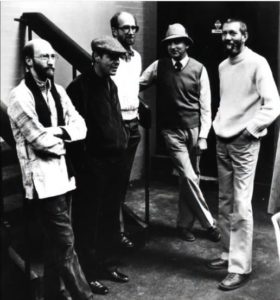 Off to London where we played the South Bank Summer Festival, the Royal Festival and Queen Elizabeth Halls, and finished our World Tour with a flourish: a solo concert at Royal Albert Hall for the BBC Proms with the London Sinfonietta! Our repertoire was Music for Pieces of Wood, Rain Tree, and Third Construction, a tribute to the three composers, Reich, Takemitsu and Cage, who already had had such an influence on our 13-year-old ensemble. Photos: playing Music for Pieces of Wood, and a backstage shot taken in England at that time. Read more: Bill Cahn’s book “Unpopular Music”, billcahn@aol.com
Off to London where we played the South Bank Summer Festival, the Royal Festival and Queen Elizabeth Halls, and finished our World Tour with a flourish: a solo concert at Royal Albert Hall for the BBC Proms with the London Sinfonietta! Our repertoire was Music for Pieces of Wood, Rain Tree, and Third Construction, a tribute to the three composers, Reich, Takemitsu and Cage, who already had had such an influence on our 13-year-old ensemble. Photos: playing Music for Pieces of Wood, and a backstage shot taken in England at that time. Read more: Bill Cahn’s book “Unpopular Music”, billcahn@aol.com
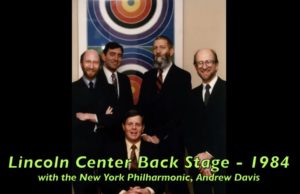 #NEXUSat50 1984 NEW YORK PHILHARMONIC DEBUT After we had “come down” from our World Tour, we headed to PASIC in Ann Arbor, Michigan where we performed with two Greats: the extraordinary Glen Velez and the legendary Percy Danforth (“Mr Bones”) who was 84 in 1984 and had been playing since he was eight. You can listen to the amazing virtuosity of Glen in this video from The Met: https://www.youtube.com/watch?v=oQ1UI6F1zGA. We have gone on to a continued friendship with Glen. You can hear Mr Bones in action here. While in Ann Arbor, we performed with the University of Michigan Orchestra under the baton of a young Carl St.Clair. This was a trial run of John Wyre’s “Connexus” – a lead-up to our return to Lincoln Center a week later for our debut with the New York Philharmonic under maestro Andrew Davis. (He had conducted the Toronto Symphony in this piece the previous year). We had four (count em’, four) performances of the piece that week. The New York Times review said in part, “…Mr. Wyre’s score is a beguiling…example of pan-cultural fusion. The primary and most pleasing influence seems to be from Bali, with a lovely evocation of a gamelan, reminiscent of Colin McPhee and Lou Harrison. . . The first categorization this piece challenges is the division between ”East Coast” and ”West Coast”…Toronto is nearer the East than the West, but if there was ever a West Coast work, with its gentle consonance and evocations of the Orient, ”Connexus” is it. Second, this seven-year-old score refutes whatever notions some in the East may have that the trend in new music toward the accessible and the tuneful is of recent origin… Third and last, “Connexus” proves that an orchestra such as the [New York] Philharmonic can introduce a real variety of contemporary music into its repertoire. . .” (You can read the full review by John Rockwell online at https://www.nytimes.com/1984/11/12/arts/music-john-wyre-s-connexus-by-philharmonic.html )
#NEXUSat50 1984 NEW YORK PHILHARMONIC DEBUT After we had “come down” from our World Tour, we headed to PASIC in Ann Arbor, Michigan where we performed with two Greats: the extraordinary Glen Velez and the legendary Percy Danforth (“Mr Bones”) who was 84 in 1984 and had been playing since he was eight. You can listen to the amazing virtuosity of Glen in this video from The Met: https://www.youtube.com/watch?v=oQ1UI6F1zGA. We have gone on to a continued friendship with Glen. You can hear Mr Bones in action here. While in Ann Arbor, we performed with the University of Michigan Orchestra under the baton of a young Carl St.Clair. This was a trial run of John Wyre’s “Connexus” – a lead-up to our return to Lincoln Center a week later for our debut with the New York Philharmonic under maestro Andrew Davis. (He had conducted the Toronto Symphony in this piece the previous year). We had four (count em’, four) performances of the piece that week. The New York Times review said in part, “…Mr. Wyre’s score is a beguiling…example of pan-cultural fusion. The primary and most pleasing influence seems to be from Bali, with a lovely evocation of a gamelan, reminiscent of Colin McPhee and Lou Harrison. . . The first categorization this piece challenges is the division between ”East Coast” and ”West Coast”…Toronto is nearer the East than the West, but if there was ever a West Coast work, with its gentle consonance and evocations of the Orient, ”Connexus” is it. Second, this seven-year-old score refutes whatever notions some in the East may have that the trend in new music toward the accessible and the tuneful is of recent origin… Third and last, “Connexus” proves that an orchestra such as the [New York] Philharmonic can introduce a real variety of contemporary music into its repertoire. . .” (You can read the full review by John Rockwell online at https://www.nytimes.com/1984/11/12/arts/music-john-wyre-s-connexus-by-philharmonic.html )
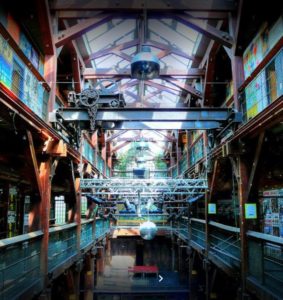
Interior of Fabrik
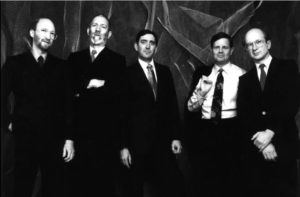 #NEXUSat50 1984 STEVE REICH and SEXTET Do you believe it? In December we headed BACK overseas, this time to France where we joined Steve Reich at the Centre Georges Pompidou in Paris for the premiere performance of “Sextet” which was commissioned for NEXUS. Bill Cahn recalls, “As is his normal practice, Reich personally assumed oversight of the sound system in order to ensure that the sound reaching the audience was as true to the acoustic sound and balance of the keyboard instruments as possible. “ The piece is written for 4 percussionists and 2 keyboards and was co-commissioned by the Laura Dean Dancers and Musicians and the French government. In 1986 the piece was recorded by Steve Reich & Musicians (which of course included some NEXUS members) on Nonesuch Records. We also performed with Steve at the unusual venue The Fabrik in Hamburg on this trip – a machine-parts factory with a cathedral-like interior. One review of “Sextet” (by Brian Olewnick) speaks of the piece’s “buoyant and jazzy bubbliness,” and says, “The closing section is pure effervescent bliss.” He also speaks of a new technique, “having the vibraphonists bow their instruments, generating long, ghostly tones reminiscent of musical saws but cleaner and more precise.” You can also read Steve’s own words in a nice review by John Baez who says, “I love this music when I’m doing mathematics or physics – the sparkling, shifting patterns sound like what my neurons are doing….” Read More: Brian Olewnick: https://www.allmusic.com/album/steve-reich-sextet-six-marimbas-mw0000160215; John Baez: http://math.ucr.edu/home/baez/favorite/reich_sextet.html
#NEXUSat50 1984 STEVE REICH and SEXTET Do you believe it? In December we headed BACK overseas, this time to France where we joined Steve Reich at the Centre Georges Pompidou in Paris for the premiere performance of “Sextet” which was commissioned for NEXUS. Bill Cahn recalls, “As is his normal practice, Reich personally assumed oversight of the sound system in order to ensure that the sound reaching the audience was as true to the acoustic sound and balance of the keyboard instruments as possible. “ The piece is written for 4 percussionists and 2 keyboards and was co-commissioned by the Laura Dean Dancers and Musicians and the French government. In 1986 the piece was recorded by Steve Reich & Musicians (which of course included some NEXUS members) on Nonesuch Records. We also performed with Steve at the unusual venue The Fabrik in Hamburg on this trip – a machine-parts factory with a cathedral-like interior. One review of “Sextet” (by Brian Olewnick) speaks of the piece’s “buoyant and jazzy bubbliness,” and says, “The closing section is pure effervescent bliss.” He also speaks of a new technique, “having the vibraphonists bow their instruments, generating long, ghostly tones reminiscent of musical saws but cleaner and more precise.” You can also read Steve’s own words in a nice review by John Baez who says, “I love this music when I’m doing mathematics or physics – the sparkling, shifting patterns sound like what my neurons are doing….” Read More: Brian Olewnick: https://www.allmusic.com/album/steve-reich-sextet-six-marimbas-mw0000160215; John Baez: http://math.ucr.edu/home/baez/favorite/reich_sextet.html
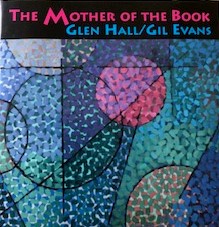
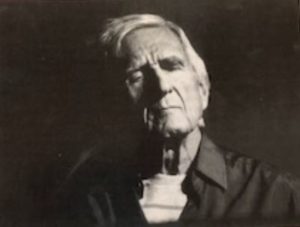 #NEXUSat50 1985 GIL EVANS and THE MOTHER OF THE BOOK We decided to stay on our own side of the Atlantic in 1985. We had outings to North Texas State and to the University of Illinois (Urbana-Champaign), enjoyed performances with Abraham Adzenya, Earle Birney, Sharda Sahai and Tim Ferchen, and performed our ragtime repertoire with the Toronto Symphony under the baton of Mario Duschenes (who received the Order of Canada that year). At the Premiere Dance Theatre in Toronto’s Harbourfront, we took the opportunity to perform our commissioned works by Hawkins and Mather, and a new commission by Milton Barnes called “Annexus”. This piece was dedicated to the memory of Michael Craden as it was the result of Michael’s and Robin’s interest following a Barnes lecture at York University. We would include “Annexus” on our “Dance of the Octopus” album a few years later. Russell Hartenberger recalls a February session at CBC’s Studio 4S for the album “The Mother of the Book”, and says, “For me, the highlight of this recording session was working with Gil Evans, the arranger of the Miles Davis ‘Sketches of Spain’ album.” The 5 pieces on the album were composed by Canadian Glen Hall and arranged by Gil Evans who at this time was 72 years old (“probably the youngest old man I’ve ever met,” recalled Sting a few years later). The extensive liner notes begin, “The Mother of the Book, Glen Hall/Gil Evans, featuring NEXUS”. We were the soloists on the piece “The Folk”; Bob Becker (on tabla) and Trichy Sankaran solo’d on the piece “The Mother of the Book”. Robin Engelman conducted “Kikue” while Gil conducted the other pieces. (InRespect – IRJ #009302). InRespect was a German record label. The album was re-released in 1994, mostly in Germany.
#NEXUSat50 1985 GIL EVANS and THE MOTHER OF THE BOOK We decided to stay on our own side of the Atlantic in 1985. We had outings to North Texas State and to the University of Illinois (Urbana-Champaign), enjoyed performances with Abraham Adzenya, Earle Birney, Sharda Sahai and Tim Ferchen, and performed our ragtime repertoire with the Toronto Symphony under the baton of Mario Duschenes (who received the Order of Canada that year). At the Premiere Dance Theatre in Toronto’s Harbourfront, we took the opportunity to perform our commissioned works by Hawkins and Mather, and a new commission by Milton Barnes called “Annexus”. This piece was dedicated to the memory of Michael Craden as it was the result of Michael’s and Robin’s interest following a Barnes lecture at York University. We would include “Annexus” on our “Dance of the Octopus” album a few years later. Russell Hartenberger recalls a February session at CBC’s Studio 4S for the album “The Mother of the Book”, and says, “For me, the highlight of this recording session was working with Gil Evans, the arranger of the Miles Davis ‘Sketches of Spain’ album.” The 5 pieces on the album were composed by Canadian Glen Hall and arranged by Gil Evans who at this time was 72 years old (“probably the youngest old man I’ve ever met,” recalled Sting a few years later). The extensive liner notes begin, “The Mother of the Book, Glen Hall/Gil Evans, featuring NEXUS”. We were the soloists on the piece “The Folk”; Bob Becker (on tabla) and Trichy Sankaran solo’d on the piece “The Mother of the Book”. Robin Engelman conducted “Kikue” while Gil conducted the other pieces. (InRespect – IRJ #009302). InRespect was a German record label. The album was re-released in 1994, mostly in Germany.
Read more: “Castles Made of Sound: The Story of Gil Evans” by Larry Hicock who provided extensive liner notes to the album.
